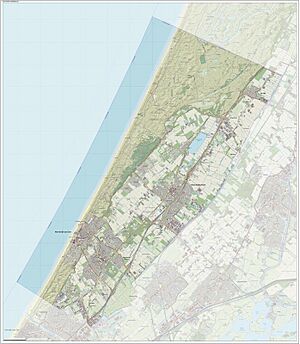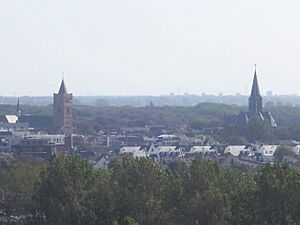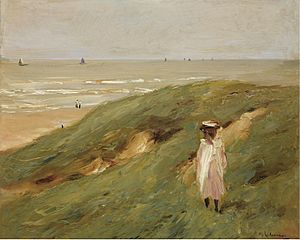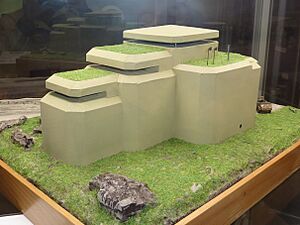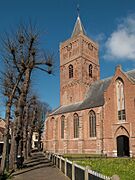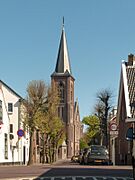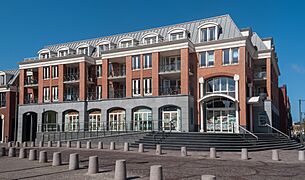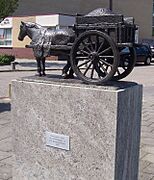Noordwijk facts for kids
Quick facts for kids
Noordwijk
|
|||
|---|---|---|---|

Aerial view over Noordwijk aan Zee
|
|||
|
|||
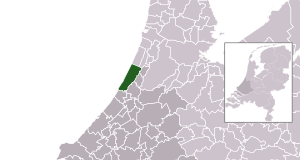
Location in South Holland
|
|||
| Country | Netherlands | ||
| Province | South Holland | ||
| Government | |||
| • Body | Municipal council | ||
| Area | |||
| • Total | 51.45 km2 (19.86 sq mi) | ||
| • Land | 35.48 km2 (13.70 sq mi) | ||
| • Water | 15.97 km2 (6.17 sq mi) | ||
| Elevation | 3 m (10 ft) | ||
| Population
(May 2014)
|
|||
| • Total | 25,600 | ||
| • Density | 722/km2 (1,870/sq mi) | ||
| Demonym(s) | Noordwijker | ||
| Time zone | UTC+1 (CET) | ||
| • Summer (DST) | UTC+2 (CEST) | ||
| Postcode |
2200–2204
|
||
| Area code | 071 | ||
| Dutch Topographic map of Noordwijk, June 2015 | |||
Noordwijk (pronounced [ˈnoːrtʋɛik]) is a town and municipality in the western part of the Netherlands. It is located in the province of South Holland. The municipality covers about 51.45 km2 (19.86 sq mi) of land and water. In 2014, it had a population of 25,600 people.
On January 1, 2019, the nearby municipality of Noordwijkerhout became part of Noordwijk.
Noordwijk is famous for its beautiful sandy beaches. It is also well-known for its colorful fields of bulb flowers, like tulips. This area is part of the "Dune and Bulb Region" (Duin- en Bollenstreek).
Noordwijk is home to the European Space Research and Technology Centre (ESTEC). This is a main part of the European Space Agency (ESA). You can visit Space Expo, which is ESA's visitor center, to learn all about space!
Contents
Exploring Noordwijk's Communities
The municipality of Noordwijk includes a few different communities. These are Noordwijk aan Zee, Noordwijk-Binnen, Noordwijkerhout, and De Zilk. Noordwijk aan Zee and Noordwijk-Binnen are separated by a small green area.
Noordwijk aan Zee: The Beach Resort
Noordwijk aan Zee started as a fishing village around the year 1200. For many years, fishing was the main job here. However, in the early 1800s, tourism began to grow.
Today, Noordwijk aan Zee is a very popular resort town. People love its long sandy beaches. About 1,000,000 people stay overnight here each year! The town has a lighthouse and a rescue station. There is also a historic church built in 1647.
Noordwijk aan Zee is known as one of the wealthiest places in the Netherlands. A very old Dutch dialect called Noordwijks was once spoken here. It is similar to the Katwijks dialect.
Noordwijk-Binnen: A Historic Village
Noordwijk-Binnen became a special pilgrimage place in 1429. This happened because of Priest Jeroen, who was martyred (killed for his beliefs) in 857. Both the Catholic and Protestant churches in Noordwijk-Binnen are named after him.
Noordwijk-Binnen has kept its old-fashioned charm. It is protected by Dutch Monument Law because of its history. An old picture by Gerard van der Laan shows the Jeroenskerk. In the front, you can see a canal with two sailboats.
The land around Noordwijk-Binnen has been important for growing bulb flowers for a long time. The sand dunes were dug out to create fields for these flowers. Noordwijk is part of the "bulb region" along with nearby towns.
Noordwijkerhout: A New Addition
Noordwijkerhout joined the municipality of Noordwijk in 2019. It is another community that is part of the larger Noordwijk area.
Nature and Dunes
North of Noordwijk, there is a large area of sand dunes. These dunes are home to many different plants and animals. You can see pine forests and even deer there. It's a great place for biking, walking, and horseback riding.
Many parts of the dunes north of Noordwijk are protected by the Natura 2000 act. This law helps to keep these natural areas safe. Part of this area is also home to the Kennemer Zweefvlieg Club.
Famous People Connected to Noordwijk
Many famous people have lived in Noordwijk or visited for rest. These include writers like Thomas Mann and Margriet de Moor. The famous educator Maria Montessori is buried in Noordwijk.
Other well-known figures include businessman Alfred Heineken and former Empress Soraya. The famous psychologist Sigmund Freud also stayed here. Painters like Max Liebermann found inspiration in Noordwijk's landscapes.
Football coach Louis van Gaal also lives in Noordwijk. In 2014, US President Barack Obama and Chinese President Xi Jinping visited Noordwijk.
A part of the 1965 movie The Spy Who Came in from the Cold was filmed in Noordwijk. This movie starred Richard Burton.
Notable People from Noordwijk
- Janus Dousa (1545–1604) was a Dutch statesman, historian, and poet.
- Henriette Roland Holst (1869–1952) was a Dutch poet.
- Freddy Heineken (1923–2002) was a Dutch businessman who led Heineken International.
- Lodewijk Woltjer (1930–2019) was a famous astronomer.
- Margriet de Moor (born 1941) is a Dutch writer.
- Leendert van Utrecht (born 1969) is a retired Dutch football player.
- Joris Putman (born 1984) is a Dutch actor.
- Janieck Devy (born 1994) is a Dutch singer-songwriter and actor.
- Jan Driessen (born 1996) is a Dutch basketball player who won a gold medal at the Paris Olympics in 2024.
World War II Bunker Complex
Just north of Noordwijk, hidden in the sand dunes, is a large complex of bunkers from World War II. These bunkers were part of the Atlantic Wall defenses built by Nazi Germany.
About 80 bunkers and underground structures were built here. They housed 180 soldiers. These bunkers were connected by 400 meters (about a quarter-mile) of tunnels. The tunnels had narrow rail-tracks to move heavy ammunition.
The main fire command bunker (called S414) was three stories deep. Its walls were up to 3 metres (10 feet) thick. This bunker alone used more than 1,800 cubic meters of concrete! Four other large bunkers held 155mm cannons and served as living areas. Two more bunkers stored ammunition.
The fire control bunker had a great view of the sea. It was used to watch for ships and calculate where to shoot the cannons. In 2001, this main bunker was opened as a museum. It has many original items inside. By the end of the war, there was almost one underground structure for every two soldiers!
Museum of Comic Art, Noordwijk
Since 2021, Noordwijk has its own comics museum. It is called the MoCA, or Museum of Comic Art, Noordwijk.
Gallery
-
Noordwijk beach on a non-summers day, when kitesurfers have all the room there
See also
 In Spanish: Noordwijk (Holanda Meridional) para niños
In Spanish: Noordwijk (Holanda Meridional) para niños



